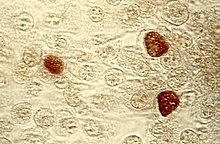Planctobacteria
| PVC group | |
|---|---|
 |
|
| Chlamydia trachomatis | |
| Scientific classification (temporary) | |
| Domain: | Bacteria |
| Superphylum: | PVC group |
| Phyla | |
| Synonyms | |
|
Planctobacteria Cavalier-Smith, 1987 |
|
Chlamydiae
Lentisphaerae
Planctomycetes
Verrucomicrobia
Planctobacteria Cavalier-Smith, 1987
Planctobacteria is a taxon created by Cavalier-Smith, specifically a division (phylum). However, it is not followed by the larger scientific community. Cavalier-Smith postulated that the Planctobacteria probably lost or reduced their peptidoglycan cell wall twice.
In the Cavalier-Smith bacterial megaclassification, it is within the bacterial Gracilicutes infrakingdom and comprises the phyla Chlamydiae, Lentisphaerae, Planctomycetes, Verrucomicrobia. It has been hypothesised that a member of the PVC clade might have been the host cell in the endosymbiotic event that gave rise to the first proto-eukaryotic cell.
These three groups in the traditional molecular phylogeny view are considered as phyla and also cluster together in what is referred to as the PVC superphylum, along with the candidate phyla OP3 and the Poribacteria. An important molecular marker in the form of a conserved signature protein has been found to be consistently shared by PVC members, with the exception of Poribacteria. The conserved signature protein may be a marker that represents a synapomorphic quality and a means to distinguish this bacterial group. Recent studies have characterized this protein and it has been attributed to play an important housekeeping function in DNA/RNA binding. This observation not only provides a means to demarcate the PVC superphylum, but it supports strongly supports an evolutionary relationship shared by this clade that is distinct from other bacteria.
...
Wikipedia
